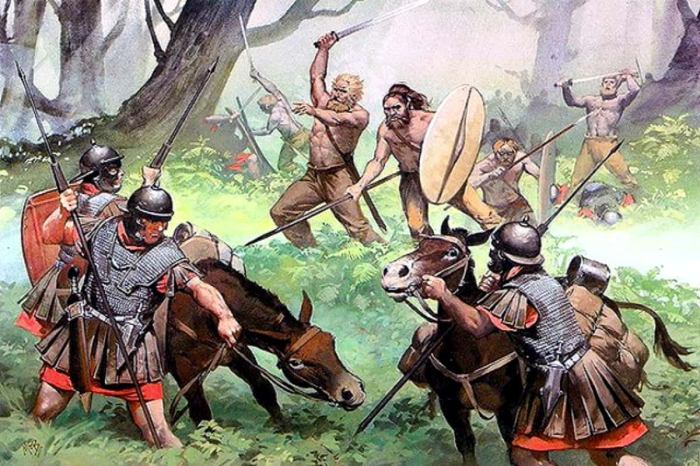How barbaric were the barbarians dbq – The question of how barbaric the barbarians were has captivated historians for centuries. In this essay, we will delve into the depths of this complex topic, examining the historical context, causes, and consequences of barbarian migrations. Through a meticulous analysis of primary and secondary sources, we will shed light on the multifaceted nature of barbarian societies and their profound impact on the Roman Empire.
The term “barbarian” has been used throughout history to describe non-Roman peoples, often with negative connotations. However, this label is highly subjective and fails to capture the diversity and complexity of the various groups that came into contact with the Roman Empire.
Defining “Barbarian”

The term “barbarian” is a loaded one, carrying with it a variety of connotations and biases. In the historical context of the period being studied, it was used by the Romans to refer to any group of people who did not share their culture, language, or way of life.
These groups were often seen as uncivilized and inferior, and the term “barbarian” was often used in a derogatory sense.
There are many examples of groups that the Romans considered to be barbarians. These include the Celts, the Germans, the Slavs, and the Huns. These groups were often nomadic or semi-nomadic, and they had very different customs and beliefs than the Romans.
They were often seen as a threat to the Roman Empire, and the Romans frequently fought wars against them.
The term “barbarian” is a complex one, and it is important to be aware of the biases and limitations of using it. The term was often used by the Romans to justify their own conquest and domination of other peoples.
It is important to remember that the Romans were not the only people who used the term “barbarian.” Other groups, such as the Greeks and the Persians, also used the term to refer to people who were different from them.
Causes of Barbarian Migrations
Barbarian migrations, characterized by the mass movement of non-Roman peoples into the Roman Empire, were triggered by a complex interplay of factors. Climate change, population growth, and political instability served as the primary catalysts for these migrations.
Climate Change
- Drought and desertification in Central Asia and Eastern Europe forced nomadic tribes to seek new grazing lands.
- The Huns, a nomadic confederation from the Mongolian steppes, were driven westward by a severe drought in the 4th century CE.
- The Goths, originally from Scandinavia, migrated southward into the Balkans in search of more fertile lands due to a prolonged period of cold and drought.
Population Growth
- Increased agricultural productivity led to population growth, putting pressure on resources and land.
- Barbarian tribes faced competition for resources, resulting in conflicts and displacement.
- The Vandals, a Germanic tribe, migrated from their homeland in present-day Poland to North Africa in search of new territories to settle.
Political Instability
- Internal conflicts and power struggles within barbarian tribes led to divisions and migrations.
- External pressures from neighboring tribes or empires forced barbarians to relocate.
- The Visigoths, a Germanic tribe, migrated into the Roman Empire after being defeated by the Huns in the 4th century CE.
Barbarian Warfare and Tactics
Barbarian tribes employed diverse military strategies and tactics, often differing from the structured and disciplined approaches of the Roman legions. Their warfare was characterized by flexibility, adaptability, and a reliance on mobility and surprise.
Compared to Roman formations, barbarian armies were less organized and lacked heavy armor. They often relied on cavalry, particularly horse archers, for mobility and ranged attacks. Their infantry typically used spears, axes, and swords, and employed shield walls for defense.
Cavalry Tactics
- Horse archers were highly effective in hit-and-run tactics, harassing enemy formations from afar with volleys of arrows.
- Heavy cavalry, though less common among barbarians, could deliver devastating charges, breaking enemy lines.
Infantry Tactics
- Shield walls provided protection against enemy missiles and infantry charges.
- Spears and axes were used for close-quarters combat, while swords were more versatile weapons.
Ambush and Raiding, How barbaric were the barbarians dbq
Barbarians excelled at ambush tactics, using their knowledge of the terrain to surprise and overwhelm their opponents. They also engaged in raiding, targeting undefended settlements and supply lines.
Effectiveness
Barbarian tactics proved effective in certain combat scenarios. Their mobility and flexibility allowed them to adapt to changing battlefield conditions and exploit Roman vulnerabilities. However, they were less effective against disciplined Roman legions in open battle, particularly when facing superior infantry and cavalry.
Barbarian Culture and Society

Barbarian tribes exhibited a diverse range of social structures, customs, and beliefs. Social hierarchy was typically based on kinship and warrior prowess, with leaders often emerging from the ranks of successful warriors. They practiced polytheistic religions, venerating a pantheon of gods associated with nature, war, and fertility.Their
cultural practices significantly influenced their interactions with Romans. For instance, their emphasis on warrior culture led to frequent conflicts with the Roman Empire, as they sought to expand their territories and acquire wealth through plunder. Additionally, their polytheistic beliefs often clashed with the monotheistic Christianity of the Roman Empire, creating religious tensions.Despite
these differences, there were also some similarities between barbarian and Roman cultures. Both societies valued honor, courage, and loyalty. They shared a common interest in warfare, and both employed similar military tactics. Moreover, some barbarian tribes adopted Roman customs and technologies, leading to a gradual process of cultural exchange and assimilation.
Barbarian Impact on the Roman Empire

The barbarian migrations had a profound impact on the Roman Empire, contributing to its political, economic, and cultural decline. Barbarian tribes played a significant role in shaping the post-Roman world, influencing the emergence of new political entities and the development of European civilization.
Political Impact
The barbarian migrations weakened the Roman Empire’s political stability and territorial integrity. Barbarian tribes frequently raided and attacked Roman territories, exploiting the empire’s vulnerability. Over time, some tribes established semi-autonomous kingdoms within the empire, challenging Roman authority.
The Visigoths, for instance, sacked Rome in 410 AD, demonstrating the empire’s inability to protect its capital. The Vandals established a kingdom in North Africa, disrupting Roman trade and communication. These events undermined the empire’s prestige and eroded public confidence in the government.
Economic Impact
The barbarian migrations disrupted the Roman Empire’s economic system. Barbarian raids and invasions disrupted trade routes, damaged infrastructure, and led to the loss of productive lands. The empire’s ability to collect taxes and maintain a stable economy was severely compromised.
The influx of barbarian tribes also created a labor shortage in the Roman Empire. Many Romans were displaced or enslaved, leading to a decline in agricultural production and a shortage of skilled workers. This further weakened the empire’s economic stability.
Cultural Impact
The barbarian migrations had a significant impact on Roman culture. Barbarian tribes brought their own customs, beliefs, and languages, which influenced Roman society. The adoption of Germanic legal codes and the rise of Christianity among the barbarians contributed to the transformation of Roman culture.
The barbarian migrations also led to the loss of many Roman cultural treasures. Barbarian tribes looted and destroyed Roman cities, libraries, and works of art. This cultural loss had a lasting impact on Western civilization.
FAQ Overview: How Barbaric Were The Barbarians Dbq
Who were the barbarians?
The term “barbarian” was used by the Romans to describe non-Roman peoples, often with negative connotations. However, this label is highly subjective and fails to capture the diversity and complexity of the various groups that came into contact with the Roman Empire.
What caused the barbarian migrations?
The barbarian migrations were caused by a complex set of factors, including climate change, population growth, and political instability. These factors led to the displacement of large numbers of people, who sought new lands to settle in.
What was the impact of the barbarian migrations on the Roman Empire?
The barbarian migrations had a profound impact on the Roman Empire. They contributed to the decline of the Western Roman Empire and the rise of new barbarian kingdoms in Europe.